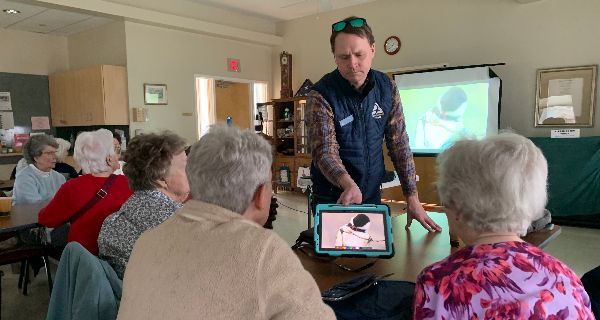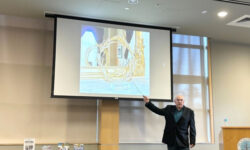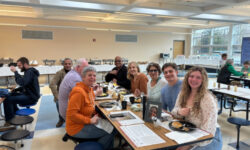By Julia Beauregard
Hometown Weekly Correspondent
Members of the Westwood Woman’s Club recently met in the dining room of the Patricia Carty-
Larkin Senior Center for a presentation by Audubon Specialist Sean Kent. The presentation discussed winter birds of New England.
Kent shared an informative slideshow of pictures with group members, which included native
birds such as the black-capped chickadee, white throated sparrow, tufted titmouse, blue jay,
Carolina wren, and crows, just to name a few. While the slideshow was projected, Kent brought
along his iPad to give members of the club a closer look at the finer details in the photos.
One of the key points of his lecture was the discussion of how animals change communication
as the seasons change. “These birds change their entire language by modifying their call,” Kent
told the crowd, before he went on to explain that the modifications of their songs are based
upon what predators are around, what they are trying to communicate, and whether it is during
mating season.
Group members delighted in listening to the various bird songs, as Kent played various
examples to explain the differences between them. The Audubon specialist provided “lyrics” for
the various tunes to help his audience understand the difference between the calls, which
brought laughter to the conference room.
Another key point in this display of feathered friends was the discussion on how these animals
survive the winters in New England. “The main goal is ‘don’t freeze and don’t starve,’” Kent
explained to the crowd.
He went on to explain that the cold temperatures not only affected the body temperature of
these animals, making it difficult to stay warm, but it also caused a decrease in the insect
population — meaning that birds have to find alternative sources of food.
Many birds pull sap from the trees they sit upon to provide them with a source of nourishment.
Other birds are common visitors at residential bird feeders and yards, feeding off of seeds.
Kent told the women that some of these smaller birds like to hide away from predators in shrubs
or bushes. He advised them to place their bird feeders near a shrub or bush if they wanted more
feathered visitors in their yards during the colder months. “It makes it more likely for birds to
come to your feeder,” he explained.
Members of the Woman’s Club delighted in the presentation, and left with a more holistic
knowledge of both their avian neighbors and their ability to tough out the Northeast’s brutal
winters.
Sean Kent is a specialist from the Massachusetts Audubon Society. For more information about
Mass Audubon, visit www.massaudubon.org.


























